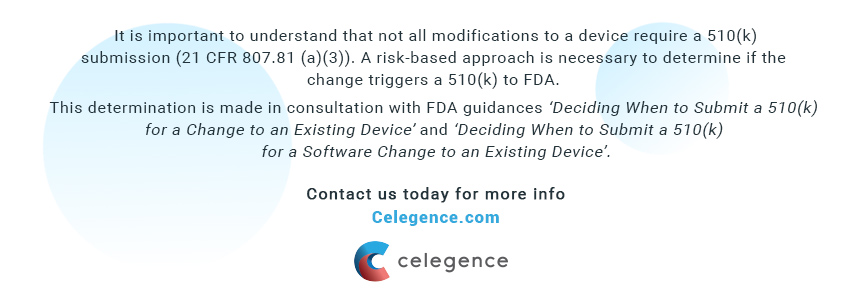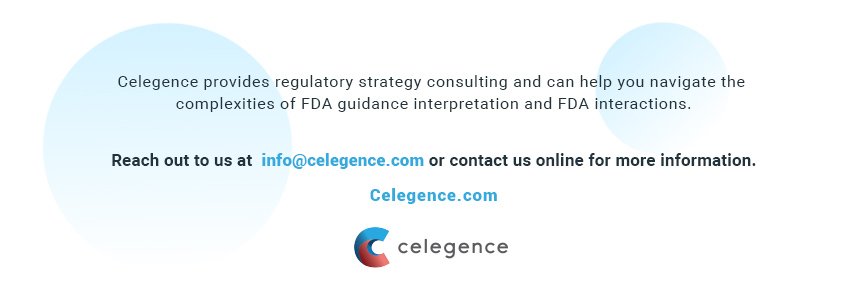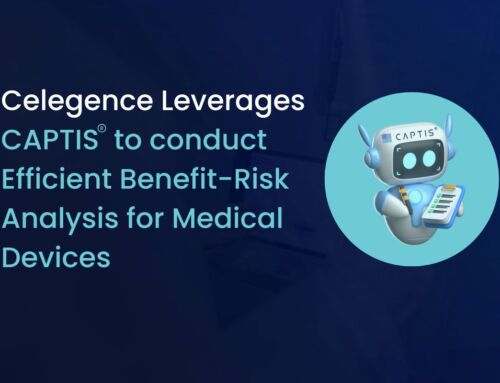
FDA Medical Device Registrations – 510(k) Submissions
Medical device manufacturers in the US can bring their products to market through different pre-market applications based on the risk classification of their device. The device classification regulation defines the regulatory requirements for a general device type. Most Class I devices are exempt from Premarket Notification 510(k); most Class II devices require Premarket Notification 510(k); and most Class III devices require Premarket Approval.
Based on the changes being made to the product, there are different types of 510(k) submissions that a manufacturer can choose. These are Traditional 510(k), Special 510(k) and Abbreviated 510(k) pathways, each associated with different review timelines. Manufacturers qualifying for a Special 510(k) are at an advantage owing to the 30-day submission processing in comparison to the 90-day submission processing timeline for a Traditional and Abbreviated 510(k).
Celegence can help you identify if your medical device qualifies for a Special 510(k) and you can benefit from the reduced processing time for your 510(k).

Claim Your Free EU MDR Checklist Now!
Make sure you and your business are compliant with the new EU MDR. Get our 23 page checklist for actionable technical documentation requirements.
Different Types of 510(k) Submissions
Based on the changes being made to the product, there are different types of 510(k) submissions that a manufacturer can choose. These are Traditional 510(k), Special 510(k) and Abbreviated 510(k) pathways, each associated with different review timelines. Manufacturers qualifying for a Special 510(k) are at an advantage owing to the 30-day submission processing in comparison to the 90-day submission processing timeline for a Traditional and Abbreviated 510(k).
Celegence can help you identify if your medical device qualifies for a Special 510(k) and you can benefit from the reduced processing time for your 510(k).
The Special 510(k) Pathway – Medical Device Submissions
The Special 510(k) pathway was previously limited to review of changes to a cleared device that did not impact its intended use or alter the device’s fundamental scientific technology. In a newly published FDA guidance, FDA has revamped this approach to make this pathway more inclusive by allowing for certain intended use changes and technological changes with well-established qualification methods to be reviewed under a Special 510(k).
Manufacturers can submit their device modifications as a Special 510(k) if they meet the following minimum requirements:
- The proposed change is submitted by the manufacturer legally authorized to market the existing device meaning the modification must be made to manufacturer’s own device
- Performance data are unnecessary, or if performance data are necessary, well-established methods are available to evaluate the change; and
- All performance data necessary to support substantial equivalence (SE) can be reviewed in a summary or risk analysis format.
The FDA guidance document “The Special 510(k) Program” issued September 13, 2019 provides information and examples of types of intended use and technological changes that may be eligible for this pathway.

Not All Device Modifications Require a 510(k) Submission
It is important to understand that not all modifications to a device require a 510(k) submission (21 CFR 807.81 (a)(3)). A risk-based approach is necessary to determine if the change triggers a 510(k) to FDA. This determination is made in consultation with FDA guidances ‘Deciding When to Submit a 510(k) for a Change to an Existing Device’ and ‘Deciding When to Submit a 510(k) for a Software Change to an Existing Device’. After this decision is made, the eligibility for a Special 510(k) can be determined based on the performance testing (if any) that are needed to qualify the change. The specific considerations for this determination is provided as a flowchart in the guidance document.
The first consideration in determining eligibility is whether the change is being made to manufacturer’s own device. The Agency is relying on previous detailed review of the same product and the robustness of the manufacturer’s design control processes through this question.
The next consideration is whether performance data is needed to evaluate the change. Some changes may be based on scientific rationale in which case the Special 510(k) needs to be accompanied with a clear rationale explaining why performance data was not deemed necessary.
Well-established Methods for Change Evaluation
In cases where the design control process leads to need for additional verification or validation testing, the next consideration is whether a well-established method exists for evaluation of the change.
The well-established methods include:
- The submitter’s methods, protocols, and acceptance criteria used to support the previously cleared 510(k) that can be applied to the subject 510(k);
- Methods found in an FDA-recognized voluntary consensus standard or FDA guidance document;
- Qualified medical device development tools (MDDTs); or
- Widely available and accepted methods published in the public domain, scientific literature, or found acceptable by FDA through the submitter’s own 510(k)-clearance, a granted De Novo classification request, or premarket application (PMA) approval.
Note that not all devices have product specific guidance documents or applicable consensus standards. In such cases, use of same test methodology as described in a previous 510(k) or other pre-market applications is a suitable alternative.
The final consideration is whether the data generated can be reviewed in a summary or risk analysis format. Submission of complete test reports defeats the purpose of a Special 510(k) and may lead to conversion of the submission to a Traditional 510(k). The results from verification and validation need to be provided in a summary format or risk analysis format. This information should be sufficient to establish SE to the predicate device.
The specific instances where FDA believes a Special 510(k) is not appropriate is also described in the guidance document. This includes situations where FDA would need to review complete test reports in order to determine SE.
Convert A Special 510(k) to a Traditional 510(k)
FDA can convert the Special 510(k) to a Traditional 510(k) if SE determination cannot be made through information submitted in a Special 510(k). Such decisions have FDA management concurrence and are typically conveyed to the submitted during Refuse To Accept (RTA) review process. This type of conversion results in delays as the content of the Traditional 510(k) varies from a Special 510(k) and this data gap needs to be fixed for a complete review. Therefore, in cases where there are deviations from well-established methods and the manufacturer is unsure about use of Special 510(k) pathway, a Pre-Submission meeting with FDA can be considered to ensure success of the regulatory strategy.

FDA Guidance Interpretation Specialists
Celegence provides regulatory strategy consulting and can help you navigate the complexities of FDA guidance interpretation and FDA interactions. Reach out to us at info@celegence.com or contact us online for more information.


